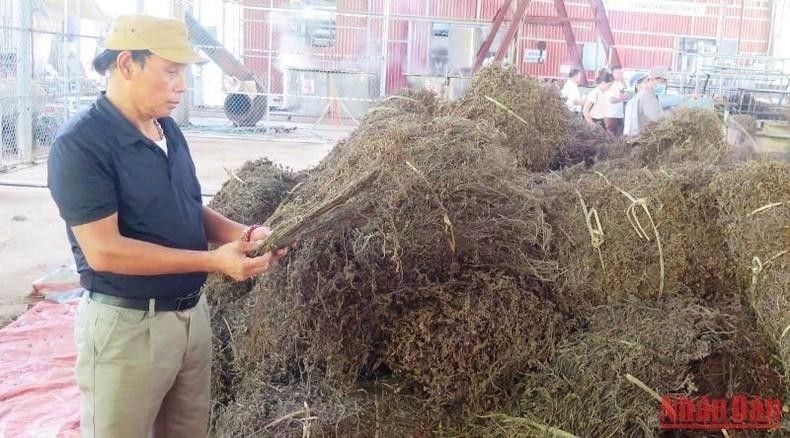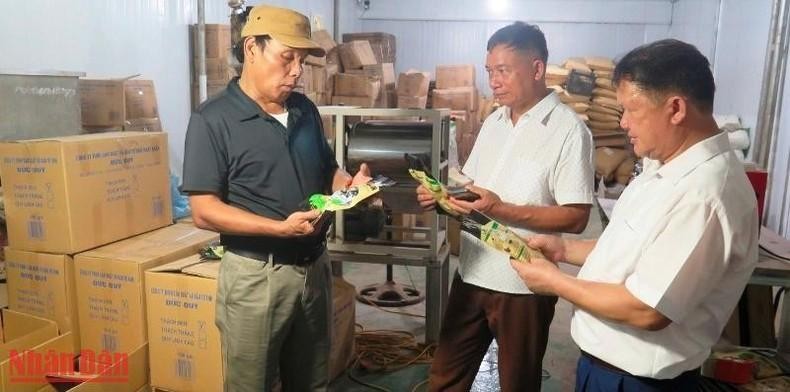Key tree to eradicate hunger and poverty
Black jelly trees have been grown in all communes in Trang Dinh District, but mainly in the communes of Kim Dong, Tan Tien, Vinh Tien, Cao Minh, Khanh Long and Doan Ket.
In the early days of August, coming to the highland villages of Kim Dong Commune, visitors can observe local people urgently harvesting the summer-autumn crop of black jelly. Dinh Thi Tuyen from Na Pan Village, Kim Dong Commune, happily shared that her family planted more than 3,600 square metres and obtained about 2.5 tonnes of dried black jelly leaves. The family has finished harvesting and drying and now just waiting for traders. She estimates it will earn about 80 million dong.
Tuyen shared that her life was difficult in the past because people grew rice in mountainous areas with low productivity. Since 2000, the locals have started to grow black jelly and their income has increased 3 times compared to rice. The products have been mainly sold to traders and exported to China in raw form, so prices are volatile.
Since 2021, black jelly trees have been officially exported to China. In the harvest season, businesses cover all with the price of 30,000-40,000 VND per kilogramme depending on the quality. Tuyen's family has had a much more prosperous life than before. She also collected black jelly for households in the village.
Secretary of the Kim Dong Communal Party Committee Hoang Van Quyet said that, with more than 240 hectares, the commune has the largest area of black jelly in the district, with an estimated output of 1,300 tonnes per hectare.
There are many households that earn hundreds of millions of Vietnamese dong and more per crop from black jelly. This has become a key tree in hunger eradication and poverty alleviation for the people. To ensure the quality of black jelly for export, the commune has been granted 14 planting area codes and 14 cooperative groups have promoted their cooperation in collecting and consuming products.
Realising the potential for the development of black jelly in Kim Dong Commune, local Ha Duc Quy decided to establish Duc Quy Import-Export Investment and Production Co., Ltd. in 2017. The factory for producing, processing and purchasing black jelly is located in Kim Dong Commune. Quy said by the end of 2019, the company had completed and installed a system of modern machinery worth 30 billion VND, including a factory area of more than 5,000 square metres. Since it began operation, the company has been purchasing 2 tonnes of black jelly per day. Up to now, the company has purchased more than 700 tonnes of black jelly powder for export to India, Malaysia and China.
Since the beginning of 2020, the company has equipped with a cooking pot that operates 24/24 hours. Its productivity of purchasing jelly trees has increased, reaching 4 tonnes per day, creating four products including black jelly powder (which was recognised as an OCOP product), white jelly and cao linh quy (herbal jelly). Thanks to effective operation, the company's revenue reached 200 million VND per month.
In addition, the company has created jobs for 50 local workers, consumes dried black jelly for locals at a stable price for exports to China. The company plans to expand the factory towards purchasing all black jelly trees in Trang Dinh District and invest in machinery to process jelly residue into microbial fertiliser to serve agricultural production in the near future.
 |
Leader of Duc Quy Import Export Trading Investment Company Limited inspects black jelly powder products for official exports to China. |
Opportunity for expanding and developing black jelly trees
Black jelly trees can be processed into soft drinks, canned fresh black jelly and jelly powder. Trang Dinh District now has six canned-instant-jelly processing establishments, annually consuming about 80 tonnes of dry jelly materials and producing 1,800-2,000 boxes per day on average, bringing economic value and income for production facilities totalling about 15 billion VND per year. Instant jelly has been consumed in Hanoi, Quang Ninh, Thai Nguyen and some southern provinces.
In 2017, the National Office of Intellectual Property of Vietnam under the Ministry of Science and Technology granted a certificate of registration of the collective trademark "Trang Dinh" for black jelly from the locality. In the beginning of December 2020, the Ministry of Agriculture and Rural Development of Vietnam and the General Administration of Customs of China signed a Protocol on phytosanitary requirements for black jelly exported from Vietnam to China, opening opportunities for official export of black jelly products.
Chairman of the Trang Dinh District People's Committee Vu Duc Thien said that the district’s Party Committee issued a resolution in early 2021 on building and developing a chain of production and consumption of products and improving the value of black jelly during 2021-2030 period.
The Trang Dinh District People’s Committee also set out a number of key tasks, including expanding growing area of black jelly trees from 2,500 hectares to 4,000 hectares from now until 2025; striving to have 100% of households growing black jelly apply technical and scientific processes in planting, caring harvesting and preserving the trees to meet standards for export; developing area codes for growing black jelly; building a black jelly production chain in accordance to export standards; and stepping up training activities and propagandising locals.
 |
Ha Thi Tuyet Nhung's household factory in That Khe Town (Trang Dinh District) produces and processes more than 2,000 boxes of instant jelly every day. |
Head of the agriculture and rural development office of Trang Dinh District Nong Thi Kim Oanh from 2021 to now, there have been 5,469 households growing jelly in 21 communes, with an area of 1,868 hectares, equivalent to 74.7% of the plan. The district's specialised agency has completed the application to the Sub-Department of Cultivation and Plant Protection to issue 104 codes in 15 communes with an area of more than 505 hectares and has completed dossiers for issuance of packing establishment codes to 58 households and cooperatives.
Presently, most people clearly understand the technical process of black jelly production and the contents of the protocol. As a result, the quality of black jelly has been getting higher and higher, meeting the criteria for official exports to markets such as China, India and Malaysia. In the coming time, the district will continue to propose that relevant agencies at all levels in the province focus on renovating black jelly trees towards higher output and quality.
Director of Lang Son Provincial Department of Agriculture and Rural Development Ly Viet Hung affirmed that since Vietnam and China signed the Protocol on official export of black jelly to China in 2020, the price of jelly has remained stable, bringing good income for farmers. The provincial leaders have been directing the districts of Trang Dinh, Binh Gia and Van Lang to expand the black jelly growing area to more than 11,000 hectares, meeting the demand for exports and making this become a key tree to alleviate hunger and reduce poverty among the local people in the province.
















